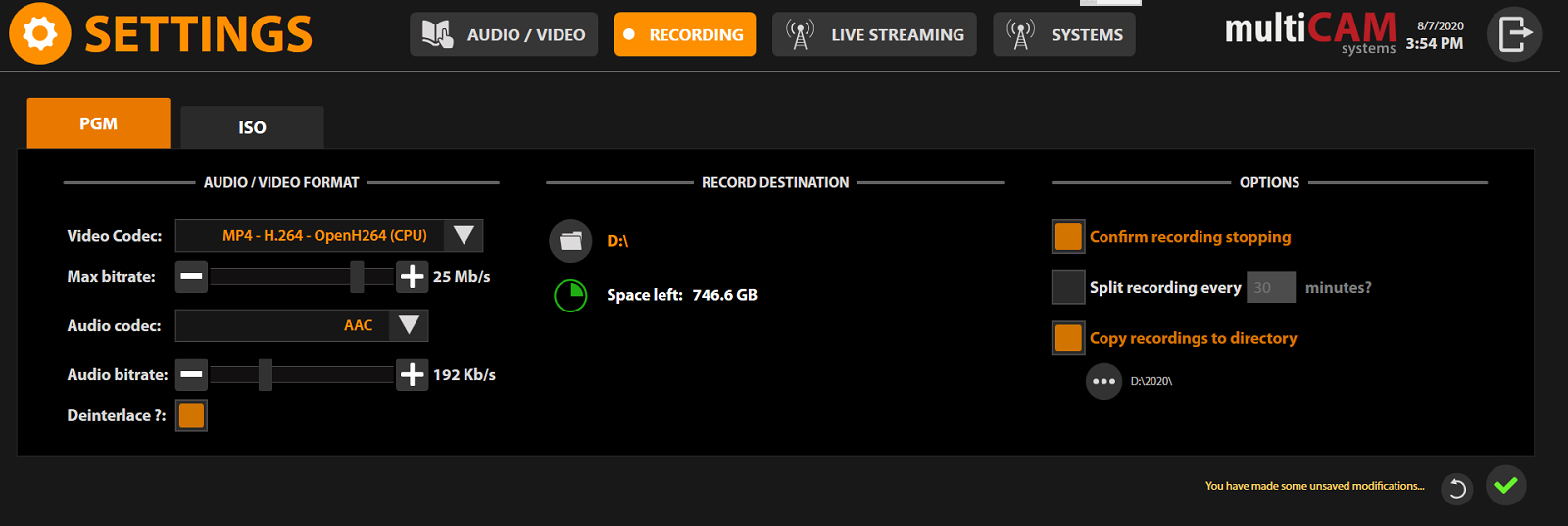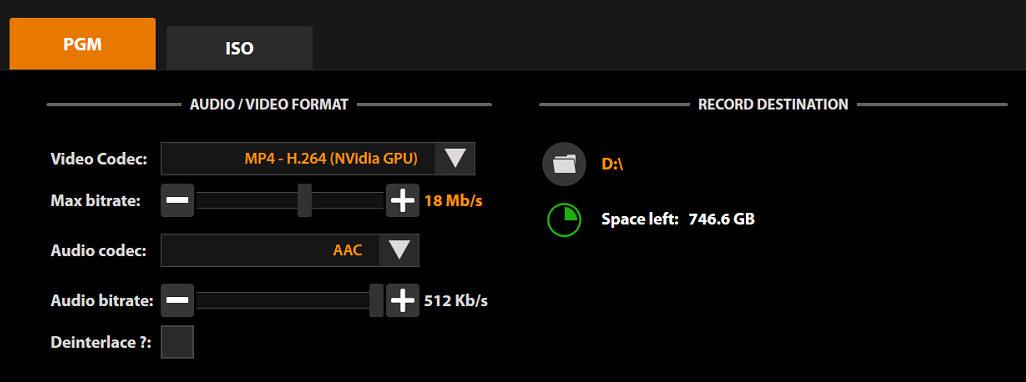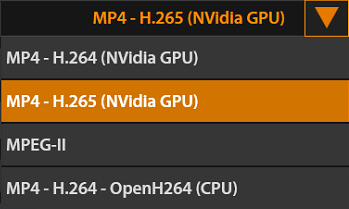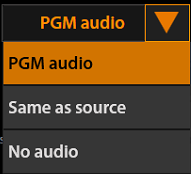Recording configuration

PGM Audio/Video formats
You can also open Recording formats configuration by clicking on the icon  attached to the button
attached to the button at the top of the user interface.
at the top of the user interface.

You can choose your recording format depending on the video system:

MP4 H.264 / H.265
The codec offers a very good size to quality ratio. It requires considerable resources for the compression/decompression. This is why MULTICAM proposes different versions:
- H.264 (CPU): The compression is carried out via the CPU
- H.264 (Nvidia GPU): The compression is carried out via the graphics card, which frees up the CPU for the other software operations.
- H.265 (Nvidia GPU): As for H.264, this codec uses GPU for decoding.
The different between H.264/AVC and H.265/HEVC:
The H.264 can support up to Full HD video
While H.265 can handle up to 8K.
You can personalize the target bitrate of the recorded video. If, for example, you would like to quickly broadcast the video (directly by streaming or through a copy on a USB drive), a low bitrate of around 2Mbps would be sufficient. If you would like to save a good quality Master archive, a bitrate of 20Mbps is recommended.
You can also choose required audio codec and quality:

SDI BOXes support 1 recording H.264 GPU + 1 live streaming H.264 GPU + 1 live streaming H.264 CPU. IP BOX supports 1 recording H.264 GPU + 1 live streaming H.264 GPU
Compatibility: Apple Final Cut Pro X, Adobe Premiere Pro, QuickTime, Windows Media, VLC.
MPEG-II
This codec is relatively old but very widely used with an interesting quality/size/performance ratio. It requires less resources than MP4 in exchange for a larger size. Give priority to this format for recordings when it comes to post-production.
Compatibility: Apple Final Cut Pro X, Adobe Premiere Pro, QuickTime, Windows Media, VLC.
PGM record destination
The recording settings interface allows you to specify the disk and the recording folder, all while indicating remaining free space.
Click on  to open the File Browser and modify the destination (by choosing, for example, a network drive or USB).
to open the File Browser and modify the destination (by choosing, for example, a network drive or USB).
The file name is automatic, following the classification:
- AAAA-MM-DD_hhmmss/Source/
- AAAA-MM-DD_hhmmss.XXX
PGM options
Split recording
An option to automatically split many video files every X minutes.
This option is especially recommended in order to avoid the loss of an entire recording in the event of a power failure. In fact, if the system unexpectedly shuts down, it will not be able to write the end of the file and read the recording.
Confirm recording stopping
This function will help to avoid stopping a recording by accident. The operator will have to confirm stopping the recording in the pop-up window.
Copy recording to directory
An option for automatic archiving in a particular folder at the end of the recording.
ISO Audio/Video formats
With the ISO recording function, you can record clean feeds from system inputs. Inside the configuration interface you can enable or disable this function and, also, synchronize start with PGM Recording.
Only one ISO channel is included in the base license.

For ISO recording, the MP4 H.264 (NVidea GPU) and MP4 H.265 (NVidea GPU) codec are availables.
The codec offers a very good size to quality ratio. It requires considerable resources for the compression/decompression.
You can personalize the target bitrate of the recorded video as well.
You can also choose required audio codec and quality:

If you enable ISO Recording with a basic license, system will use one of two GPU's.
ISO Recording sources
Video sources
Inside the video sources area you can enable or disable inputs for recording depending on your licenses.

Audio sources
There are 3 options for audio sources:
- PGM Audio - PGM audio output
- Same as source - audio from source
- No audio - without any audio
